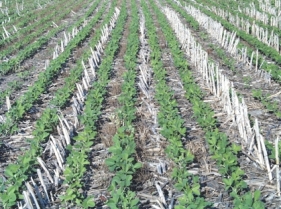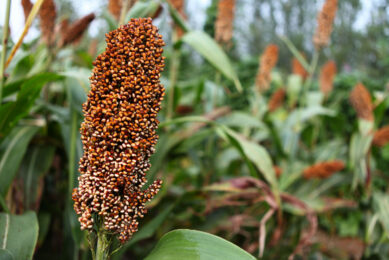Soybeans grow well in high CO2 levels

Crops responded positively to future levels of atmospheric carbon dioxide (CO2), but soil tillage practices had little effect on this response, according to a U.S. Department of Agriculture (USDA) study.
The first long-term study comparing tillage practices under high CO2 levels showed that elevated CO2 caused soybean and sorghum plants to increase photosynthesis while reducing transpiration-the amount of water the plants release.
This resulted in increased water use efficiency, whether the crops were grown with no-till or conventional tillage, according to researchers with USDA’s Agricultural Research Service (ARS). This study supports the USDA priority of responding to climate change.
6-year study
Plant physiologist Steve Prior, plant pathologist Brett Runion, and their colleagues at the ARS National Soil Dynamics Laboratory in Auburn, Alabama, found that water use efficiency response to high CO2 was much greater for soybeans than for sorghum over the 6-year study.
The outdoor study was done using open-top growth chambers for exposing the crops to the higher levels of CO2. The crops were monitored for photosynthesis and transpiration during their reproductive growth stages, when water demand is highest.
The scientists compared soybean/sorghum rotations with both conventional tillage and no-till. With no-till there is no ploughing, only minimal disturbance of the soil while planting seeds.
The scientists also compared current ambient CO2 levels—about 370 parts per million (ppm)—with levels of 720 ppm expected within this century.
Increased photosynthesis
With the higher level of CO2, regardless of tillage method, soybean photosynthesis increased by about 50%, while sorghum photosynthesis rose by only 15%.
This was expected because crops like soybean, which have a C3 photosynthetic pathway, are known to respond better to high CO2 levels than crops like sorghum and corn that have a C4 photosynthetic pathway. Most plants worldwide are C3 plants.
Sorghum’s increased water use efficiency was mainly due to less water transpired or lost through the leaf pores (stomata).
Although no-till didn’t make a difference as far as crops responding to high CO2, it can greatly reduce soil erosion, conserve soil water, and increase carbon storage, among its many benefits.
The results of this research were published earlier this year in the Journal of Environmental Quality.











